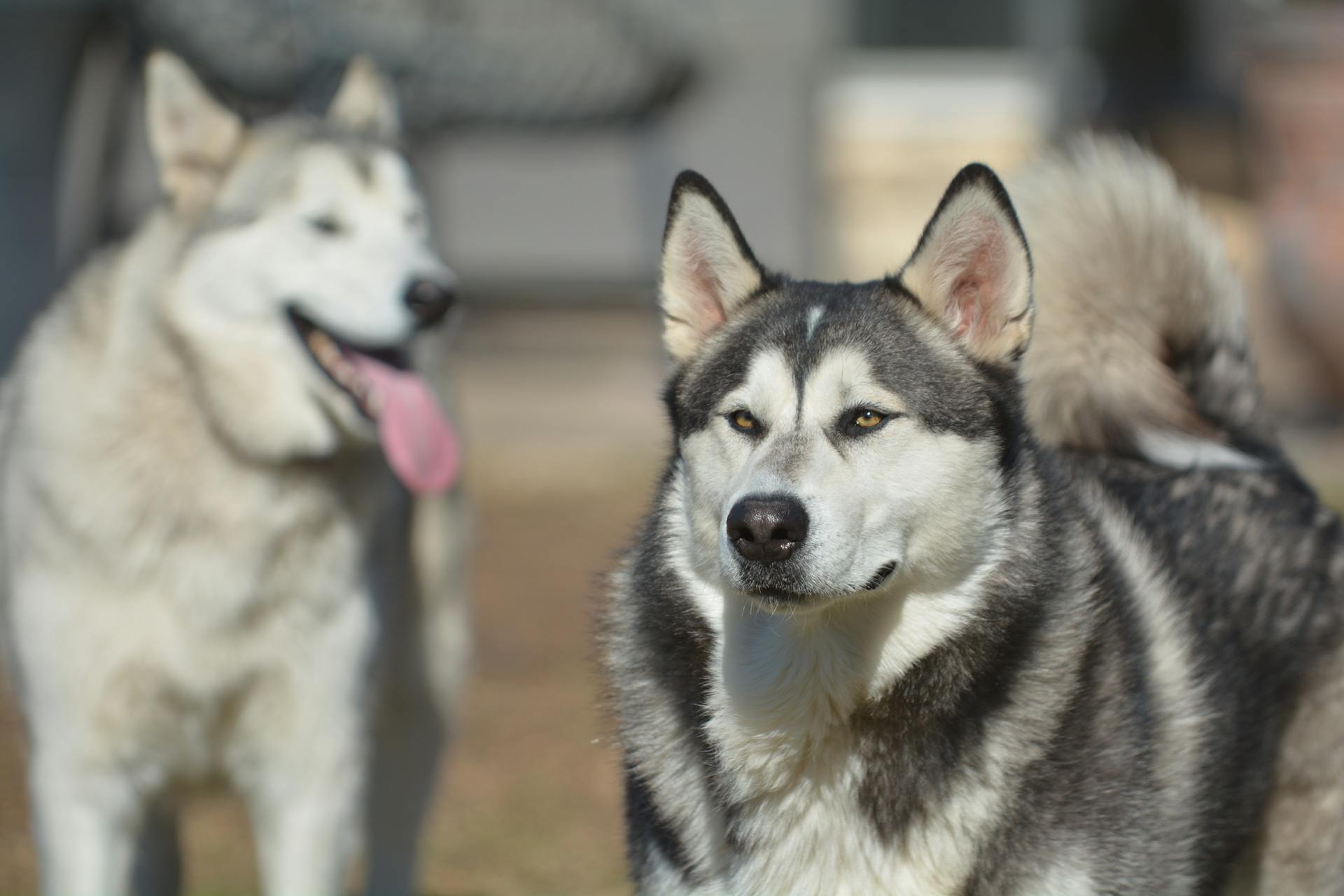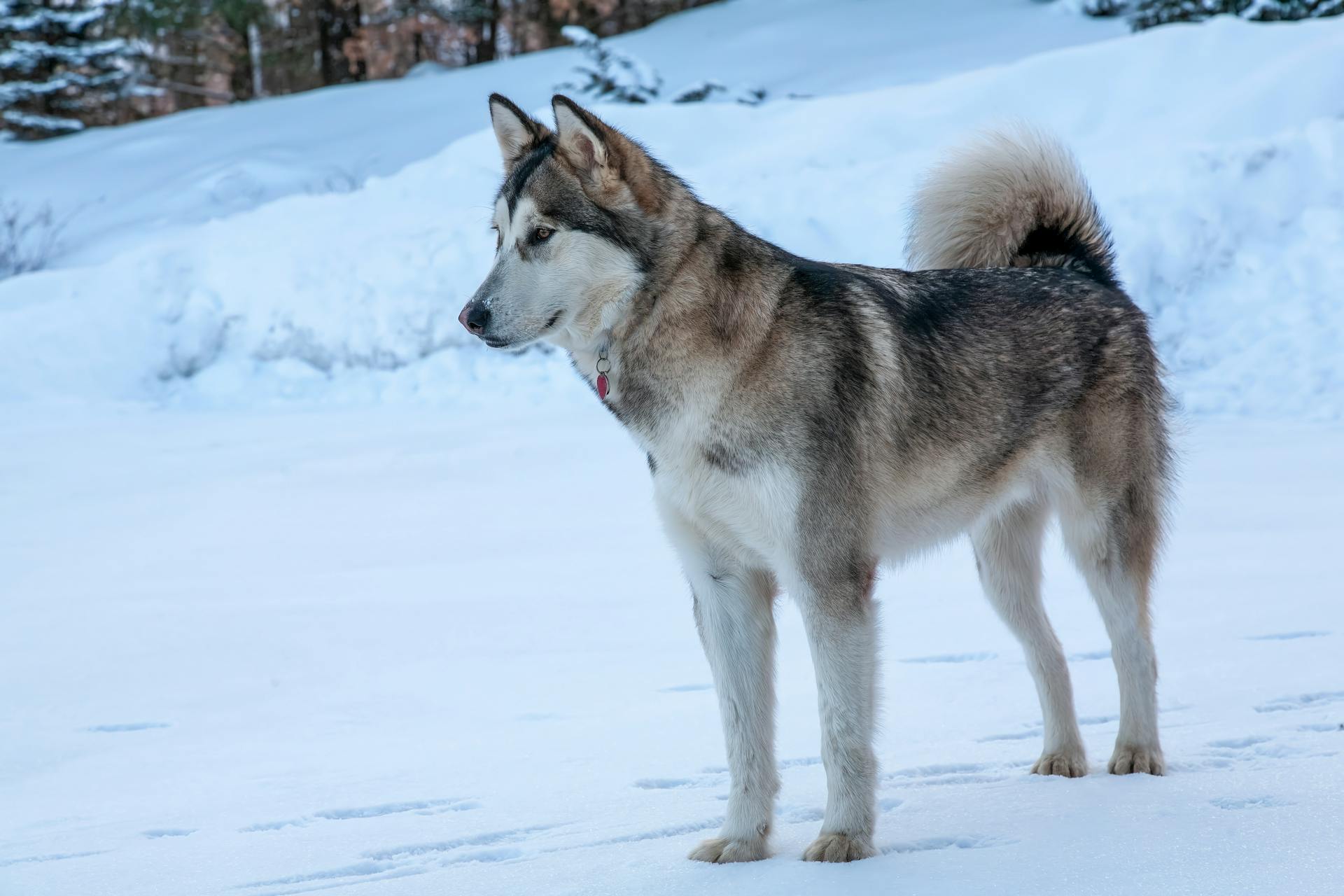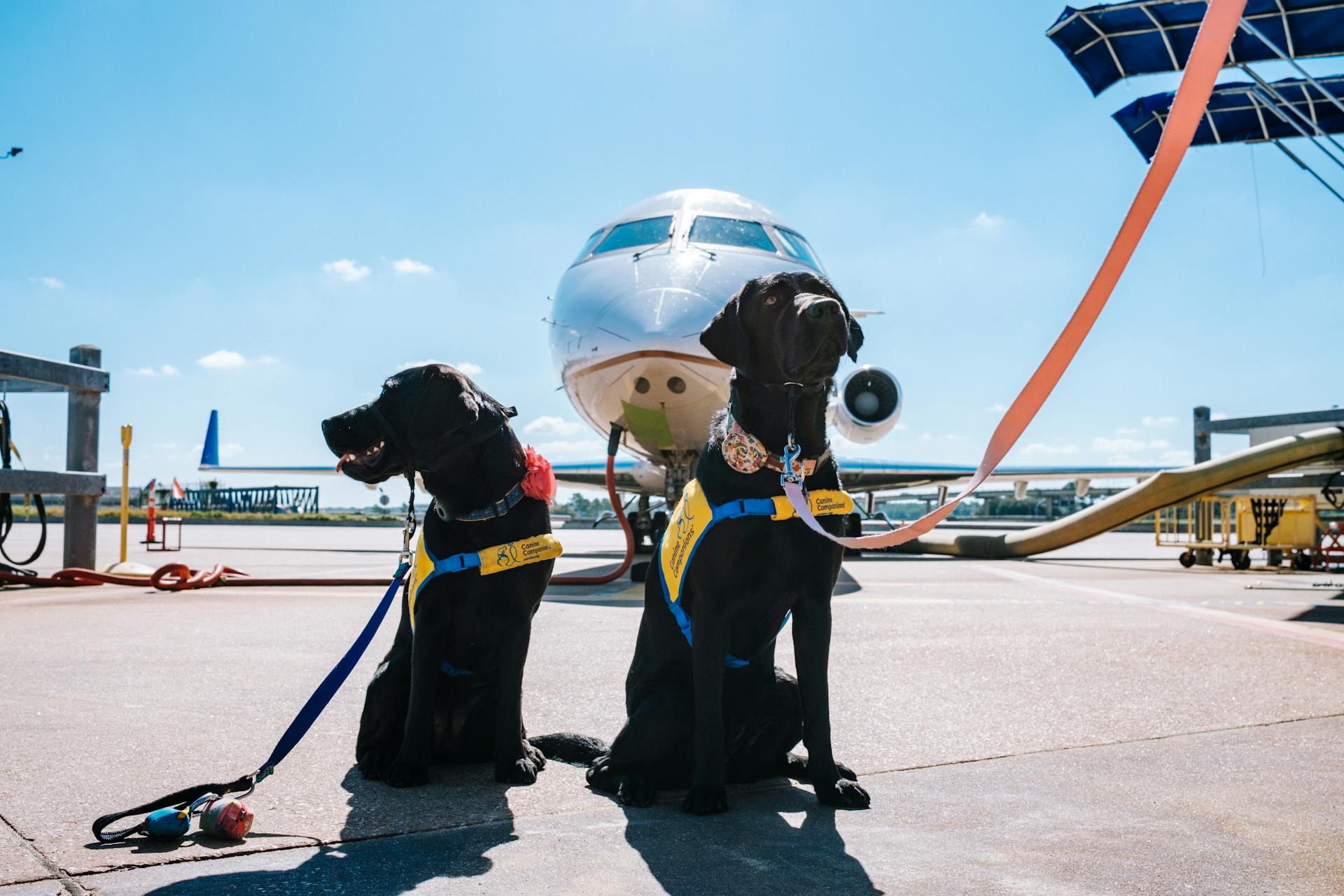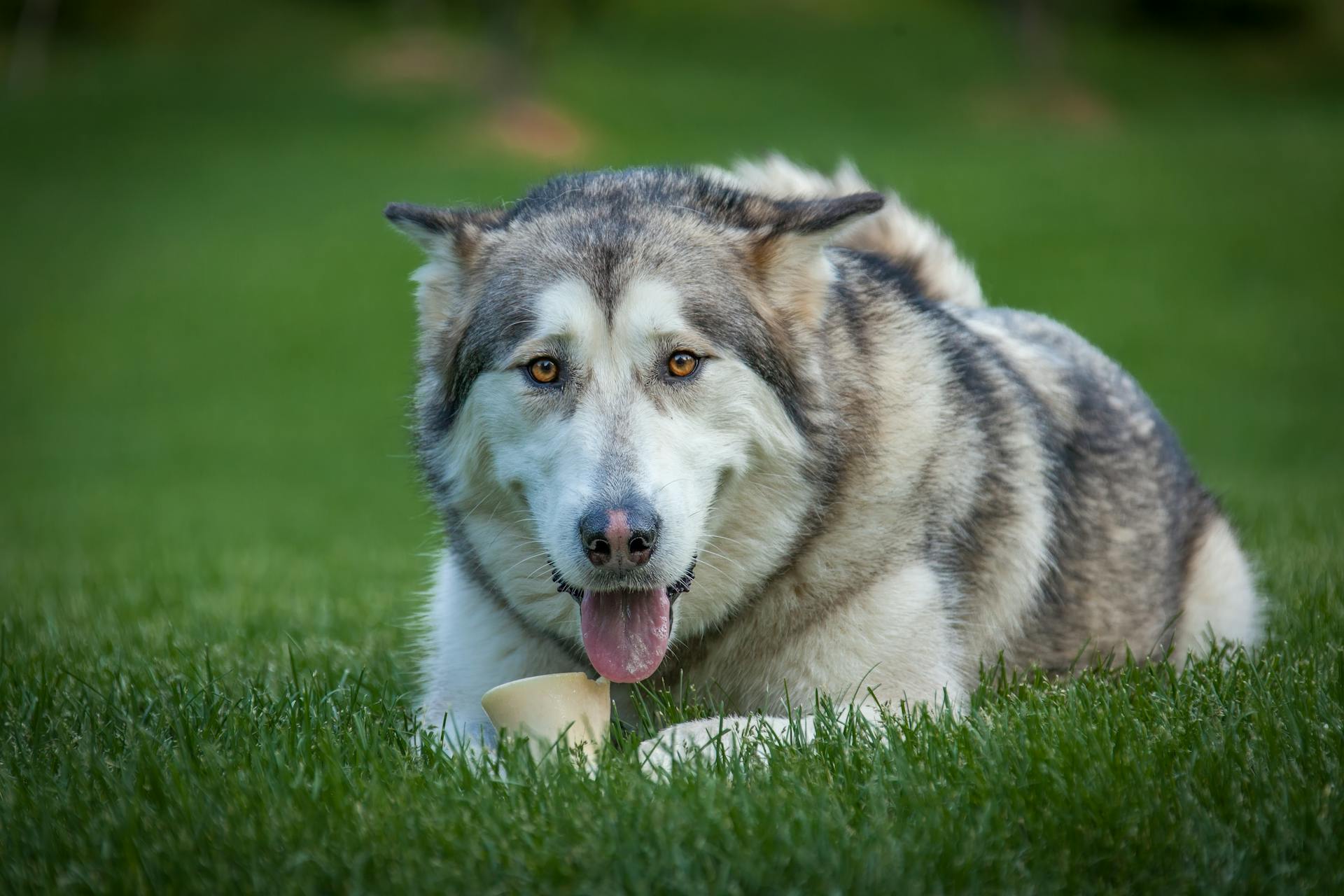
Alaska has a rich history of dog breeding, dating back to the indigenous people who relied on these loyal companions for hunting and transportation.
The Malamute is one of the oldest and most iconic Alaskan dog breeds, with a history that spans over 4,000 years.
These dogs were bred to be strong and resilient, with a thick coat that can withstand the harsh Arctic climate.
In fact, the Malamute's thick coat can be up to 8 inches thick in some areas, keeping them warm in temperatures as low as -50°F.
The Alaskan Husky is another popular breed that originated in Alaska, known for its speed and agility.
They were bred to be working dogs, pulling sleds and assisting with hunting and transportation.
Suggestion: Dog Sledding in Anchorage Alaska
Physical Characteristics
Alaskan Malamutes can grow to around 100 pounds, making them a large breed capable of withstanding extreme temperatures and heavy loads.
Their muscular and powerful body is designed for strength and stamina, with a broad head, triangular ears, and a bulky muzzle. Their furry tail is often curled over their back.
Recommended read: Dogs Breeds That Start with B
The Alaskan Malamute's coat is thick and double layered, providing protection from the elements. This is perfect for their love of cold weather.
Alaskan Huskies have a short to medium coat, unlike Siberian Huskies, and it's always soft to the touch. Their coat color is often dark, grey, or black with brown eyes.
Alaskan Huskies are taller and more slender than Siberian Huskies, allowing them to run fast in the snow and pull heavy weights. Their agile and powerful musculature makes them perfect for sled pulling.
Check this out: Do Huskies and German Shepherds Get along
Temperament and Behavior
Alaskan Malamutes are very affectionate pets that love and protect their family.
They even like children and will play with them for hours if allowed to.
These dogs need a lot of mental and physical stimulation to keep them from getting bored.
Cats and other small animals are seen as prey unless you train your dog not to hunt them.
Alaskan Malamutes are very loyal and courageous but can be strong-willed and stubborn at times.
They are easily trained and are very quick to learn.
Barking is usually not a concern, but they tend to howl if they hear a siren or other dogs howling.
They are also vocal with their owners, so don't be surprised if your Alaskan Malamute seems to be talking to you.
Alaskan Malamutes need attention and exercise with both indoor and outdoor play daily.
If they are left alone too long or get bored, they are likely to get into trouble by chewing up furniture or digging holes in the yard.
Similar Breeds
If you're looking for breeds that share similarities with Alaska dog breeds, you might want to consider the Siberian Husky. This breed is known for its thick coat and ability to withstand cold temperatures.
The Alaskan Malamute is another breed that's often compared to Alaska dog breeds due to its strength and endurance. They're built for pulling heavy loads and can thrive in cold climates.
For more insights, see: Perro Alaska Malamute
The Samoyed is a smaller breed that shares some similarities with Alaska dog breeds, including a thick coat and friendly demeanor. They're highly social and love to be around people.
The Inuit Dog is a rare breed that's well-suited to the harsh Arctic environment. They're highly intelligent and can be trained for a variety of tasks, from hunting to herding.
The Canadian Eskimo Dog is another breed that's similar to Alaska dog breeds. They're highly energetic and require regular exercise to stay happy and healthy.
Lineage and History
The Alaskan Malamute and other Alaska dog breeds have a rich history that spans over 4,500 years. They descended from the Eskimo dogs of Greenland, Siberian Huskies, and the Russian Samoyed.
Their ancestors were used by the Mahlemuts as hunting dogs to hunt polar bears and seals, and they were also used as sled dogs. The breed was later bred with other breeds to increase speed, but this caused the breed to be diminished.
In the 1920s, breeders started trying to purify the breed again, resulting in the Alaskan Malamute as we know it today. The breed was officially recognized by the American Kennel Club in 1935.
The Alaskan Malamute was used in World War II as a working dog alongside soldiers in battle. They were also used in Antarctic expeditions, such as Richard Byrd's expedition in 1933.
Here's a brief timeline of the Alaskan Malamute's lineage:
- 4,500 years ago: Malamutes descended from Eskimo dogs of Greenland, Siberian Huskies, and Russian Samoyeds
- 1700s: Explorers were impressed by the Alaskan Malamute's strength and affection, increasing the breed's popularity
- 1896: Malamutes were used in weight-pulling competitions during the gold rush
- 1920s: Breeders started trying to purify the breed again
- 1933: Malamutes were used in Antarctic expeditions
- 1935: The Alaskan Malamute was officially recognized by the American Kennel Club
The Alaskan Malamute's history is a testament to their strength, endurance, and loyalty. They have been a valuable companion to humans for centuries, and their legacy continues to inspire and awe us today.
Specific Breeds
Alaska is home to many incredible dog breeds, each with its own unique characteristics and abilities.
The Malamute is a powerful and sturdy breed that originated in Alaska, known for its strength and endurance.
The Inuit people have bred the Alaskan Husky for centuries, selecting for speed and agility.
The Alaskan Malamute's thick coat helps it thrive in the harsh, cold climate of Alaska.
The Alaskan Husky's friendly and outgoing personality makes it a popular choice for families.
Siberian Husky
The Siberian Husky is a breed that's quite similar to the Malamute, but with some key differences. It's capable of pulling heavier loads, but isn't as persevering as the Malamute.
They typically weigh between 18 and 27 kg, making them a relatively lightweight breed. This weight range is the same as the Alaskan Husky, but the Siberian Husky is bred for its ability to pull heavy loads.
The Siberian Husky has been selectively bred for both its looks and its ability to pull heavy loads. This selective breeding has resulted in a breed that's well-suited for sled pulling.
Ryan Anderson and his dogs crossed the finish-line first in Grand Portage, making him the John Beargrease Sled Dogs champion. This achievement showcases the Siberian Husky's ability to excel in sled racing.
The name "canicross" is a combination of the words "canine" and "cross-country", which is a great description of the sport. Canicross is simply cross-country running with your dog, and the Siberian Husky is well-suited for this type of activity.
For your interest: English Cocker Spaniel Field Bred
Chinook
The Chinook is a relatively rare breed of sled dogs, developed in New Hampshire in the early 1900s.
It's a blend of several breeds, including the English Mastiff, Greenland Dog, German Shepherd Dog, and Belgian Shepherd.
Their robust body and tireless gait make them well-suited for sled pulling.
Their coat color is always tawny, ranging from a pale honey color to reddish-gold.
Consider reading: Alaskan Sled Dog Breeds
Other
Alaska is home to a wide range of dog breeds, but some don't quite fit into the categories of working, sporting, or companion dogs. These breeds are often smaller in size and have unique characteristics.
The Alaskan Klee Kai, for example, is a small to medium-sized dog that originated from the Alaskan Husky. They're known for their friendly and outgoing personalities, making them great family pets.
In terms of grooming, the Alaskan Klee Kai has a thick double coat that sheds heavily, requiring regular brushing and grooming. This is similar to other breeds like the Alaskan Malamute and the Siberian Husky, which also have thick coats that require regular maintenance.
A fresh viewpoint: Dog Breeds That Don't Need Grooming
Health

In the realm of health, there's a fascinating connection between our gut and brain. Research has shown that the gut microbiome produces neurotransmitters that can influence our mood and cognitive function.
The human gut contains trillions of microorganisms, with some studies suggesting that the gut microbiome is more than 50% of our immune system.
A healthy gut microbiome is essential for proper digestion and nutrient absorption, which is crucial for maintaining energy levels and overall well-being.
In fact, a study found that individuals with irritable bowel syndrome (IBS) had significantly lower levels of certain beneficial bacteria in their gut compared to healthy individuals.
Maintaining a balanced gut microbiome can be achieved through a diet rich in fiber and fermented foods, such as yogurt and kimchi.
Some research suggests that a high-fiber diet can increase the production of short-chain fatty acids, which can help reduce inflammation in the body.
A study found that individuals who consumed a high-fiber diet had improved symptoms of IBS and reduced inflammation in the gut.
Exercise has also been shown to positively impact gut health, with one study finding that regular physical activity increased the production of beneficial bacteria in the gut.
Overall, taking care of our gut health is essential for maintaining a healthy brain and body.
Discover more: Embark Breed and Health Dog Dna Test Stores
None

It's interesting to note that "None" doesn't necessarily mean the absence of something, but rather a specific category that exists in its own right.
The concept of "None" is often overlooked, but it plays a crucial role in many areas of life, including mathematics and logic.
In mathematics, "None" can be represented as the empty set, denoted by {} or ∅, which has no elements.
This concept is essential in understanding the foundations of mathematics and has far-reaching implications in fields like computer science and engineering.
The idea of "None" is also present in everyday language, where it's used to indicate the absence of something or someone.
Frequently Asked Questions
What is the official dog breed of Alaska?
The official dog breed of Alaska is the Alaskan Malamute, designated as such in 2010. This iconic breed was championed by school kids as part of a class project.
Are Alaskan Malamutes good family dogs?
Alaskan Malamutes can make great family pets, but they require careful consideration due to their large size and energetic nature. They're best suited for families with older children who can interact with them safely.
What is the best Alaskan dog?
The Alaskan Husky is a top-performing sled dog, bred for speed, endurance, and strength. Its origins from Siberian Huskies make it a unique and impressive breed.
What dog breed is an Alaskan puppy?
The Alaskan puppy is a Malamute, a native Arctic breed originating from Alaska. This ancient breed is closely related to other Arctic breeds, including the Samoyed and Siberian Husky.
What breed is a white fluffy Alaskan dog?
The American Eskimo Dog is a white fluffy breed known for its intelligence and distinctive lion-like mane. Learn more about this friendly and intelligent breed.
Featured Images: pexels.com

